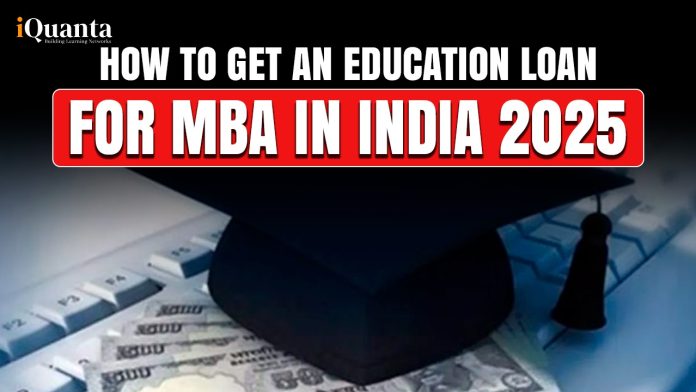Planning to do an MBA from a prestigious college, but the associated huge fee is a big concern. Now you are considering an education loan for MBA, but the process seems confusing and exhausting. Do not worry! you are not alone. If you are not sure where to start, this article is for you. We will walk you through 7 simple steps on how to get an education loan fo MBA in India in 2025:
- Understand the total cost of your MBA course in India
- Check you eligibility
- Compare lenders
- Gather your documents
- Apply for the education loan
- Wait for sanction and disbursement
- Understand the repayment

Step 1: Understand the Total Cost of Your MBA
Before you apply for an education loan for MBA in your preferred college, you need to fully understand all the costs that are associated with your program. The following are the various fees that are charged:
- Tuition fees
- Hostel and mess charges
- Laptop, books, and study material
- Travel and personal expenses
- Exam or semester fees
Now, let us see the approximate fees for some of the top B-schools in India in 2025:
| B-School | Approximate Fees (INR) for the entire course |
| IIM Ahmedabad | INR 35 lakhs |
| IIM Bangalore | INR 33 lakhs |
| IIM Calcutta | INR 33.5 lakhs |
| IIT Delhi (DMS) | INR 12 lakhs |
| FMS Delhi | INR 2 lakhs |
| IIFT Delhi | INR 22 lakhs |
Knowing the total fees helps you choose the amount for an education loan for MBA and can help you with your financial planning as well.
Step 2: Check Your Loan Eligibility
Every bank or NBFC (Non-Banking Financial Company) has different eligibility criteria that you need to meet before you can get an education loan for MBA. The following are some of the basic requirements:
- You must be an Indian citizen
- You should have confirmed admission to a recognized MBA institute
- A co-applicant (parent, sibling, guardian) is required
- Good academic performance and a strong co-applicant financial profile improve your loan terms like lesser interest rates and more.
Checking loan eligibility with every bank can be a time-consuming and frustrating process, therefore, at GyanDhan, you can check your loan eligibility in a few minutes for various lenders in one place and can get a personalised document checklist and dedicated education loan counsellor who will guide you with the loan application process, and the best part is, the entire process is absolutely free of cost!
Step 3: Compare Lenders
As we have discussed earlier, you can get education loans from public banks, private banks and NBFCs. But please note that, in the next step, education loan for MBA interest rate and other factors like loan amount, moratorium period, repayment tenure, pre-payment terms and more are to be compared. We have given tables below to compare these loan features, but please note that it is not an exhaustive list and there are more lenders in each category.
Public Sector Banks
| Bank | Maximum Loan Amount | Interest Rate | Collateral Requirement | Processing Fees | Repayment Tenure |
| State Bank of India (SBI) | Up to INR 50 lakhs (without collateral) | 10.15% with 0.50% concession for female students | Collateral required for loans above INR 7.5 lakhs | Nil for loans up to INR 20 lakhs. INR 10,000 + taxes for higher amounts | 15 years |
| Bank of Baroda | Up to INR 1.5 cr | Baroda Repo Linked Lending Rate (BRLLR)+ 0.25% | Collateral required for loans above INR 7.5 lakhs | 1% of the loan amount. Zero for loan upto INR 7.5 lakhs | 15 years |
| PNB (Punjab and Sind Bank) | Up to INR 25 lakhs | 12.5% with 0.5% concession for female students | Collateral required for loans above INR 7.5 lakhs | 1% of the loan amount. Zero for loan upto INR 4 lakhs | 15 years |
| UBI (Union Bank of India) | Up to INR 1.5 cr | Based on loan amount and collateral with concession for female students | Collateral required for loans above INR 7.5 lakhs | Zero for loan upto INR 4 lakhs, but applicable for higher amount | 15 years |
Private Sector Banks
Private banks often provide faster processing but interest rates are slightly higher.
| Bank | Maximum Loan Amount | Interest Rate | Collateral Requirement | Processing Fees | Special Features |
| ICICI Bank | Up to INR 1 crore | REPO Rate + 3.75% (Spread) onwards | Collateral required for loans above INR 7.5 lakhs | 1% of the loan amount | Special terms for professionals with work experience. |
| Axis Bank | Up to INR 75 lakhs | 13.70% for loans above INR 7.5 lakhs | Collateral required for loans above INR 7.5 lakhs | INR 15,000 + GST | Flexible repayment options with a tenure up to 15 years. |
| Yes Bank | Up to INR 50 lakhs | Starting from 10.75% | Collateral may be required based on the loan amount and institution | 1% of the loan amount | Flexible repayment options. |
| Tata Capital | Up to INR 30 lakhs | 11.00% to 13.50% | Collateral may be required based on the loan amount and institution | 1% to 2% of loan amount | Pre-admission sanctions with no margin money requirement |
Non-Banking Financial Companies (NBFCs)
NBFCs offer flexible loan options, faster processing and higher approval chances making these NBFCs useful to students who are not able to get education loans from public and private banks.
| NBFC | Maximum Loan Amount | Interest Rate | Processing Fees |
| HDFC Credila | No upper limit | Variable | 1% of the loan amount |
| Auxilo | Up to INR 1 crore | Starting from 11.25% | 1% to 2% of loan amount |
| Avanse | Up to INR 50 lakhs | Starting from 11.50% | 1% of the loan amount |
| InCred | Up to INR 40 lakhs | Starting from 11.75% | 1% to 1.5% of loan amount |
Important Terms To Note
- If none of the above lenders are suitable, please do not worry, there are more lenders in each category with variable loan terms and conditions.
- Interest Rates: Interest rates can vary based on the lender and loan amount. It’s crucial to compare rates to ensure affordability.
- Processing Time: Private banks and NBFCs may offer faster processing times compared to public sector banks.
- Repayment Terms: Understand the moratorium period, repayment tenure, and any prepayment charges associated with the loan.
Step 4: Gather Documents Required for Education Loan for MBA
This is an important step where you have to submit the documents required for education loan MBA in a timely manner. Please note that all the documents you submit are updated and accurate.
For student
- Admission letter from a recognized college
- KYC documents (Aadhar, PAN, Passport, and more)
- Academic records (10th, 12th, graduation)
For co-applicant
- Income proof (salary slips, ITR, Form 16)
- ID and address proof
- Bank statements (last 6 months)
For collateral (if taking a secured loan):
- Property documents
- Title deed
- Valuation and legal reports
Step 5: Apply for the Loan
You can apply online or visit a bank branch. Many NBFCs offer doorstep services for document pickup. You can also use the PM Vidyalakami Portal to apply for education loans.
It is a unified portal by the government of India for students who want to apply for education loans from banks in India.
Step 6: Wait for Sanction and Disbursement
Once you have applied for an education loan for MBA and submitted the relevant documents, along with the processing fee (if any), then the following steps will take place.
- The bank will evaluate your application and check your eligibility.
- If you meet all the criteria set internally by the lender, then your loan application gets approved.
- Once approved, you receive a sanction letter, which has all the important terms and conditions of your loan. Please go through the sanction letter carefully.
- You must sign the agreement to proceed. There is a time limit to it, and if it expires, you need to re-do the entire loan application process. So, do not miss the deadline for signing the agreement.
- Funds are usually disbursed directly to the institute account or as per the lender’s policies.
The entire process takes time between 15-20 days, in the case of NBFC, it takes around 7-10 working days.
Step 7: Understand the Repayment
Once your loan is disbursed, it is very important to understand the repayments required, because if you fail to repay on time, then there are severe consequences, including legal action against you and a considerable reduction in your CIBIL score, thus prohibiting you from taking any loan in the future. Keep in mind the following points and read the sanction letter to better understand repayment terms:
- Most banks offer a moratorium* period, that is you do not have to pay anything during this period, but interest will continue to accrue.
- Repayment tenure is usually 7 to 15 years, which is the time you have to repay the entire loan along with the interest.
- You can repay your education loan by monthly installments. Please note that you can also pre-pay a part of your loan, which will help in reducing financial pressure.
- Check with your lender, if there is any prepayment penalty or not.
*Moratorium period: It is the time period during which you are free from paying anything to your lender. It usually covers your course length and an additional 6-12 months.
Final Tips
- Check if your MBA college is on a premier list (IIMs, XLRI, and more). An education loan for MBA are easier for such top colleges and terms are relaxed too.
- Look for scholarships or interest subsidy schemes. These can save a lot of your money, time and investments.
- Always read the fine print. Know about hidden charges, prepayment penalties, and interest calculation of your education loan.
Getting an education loan for MBA is not as hard as it seems. With a bit of research and proper planning, you can get an education loan for your dream B-school without worrying about the expenses and repayment. The key is proper planning and assistance. You have to start early, compare options, and go with the one that fits your needs best. A good education loan is not just about the lowest interest rate, it is about flexibility, easy repayment options and most importantly, peace of mind. All the best for your MBA journey ahead!


